RBSE Solutions for Class 9 Information Technology Chapter 3 Computer Communication and Network are part of RBSE Solutions for Class 9 Information Technology. Here we have given Rajasthan Board RBSE Class 9 Information Technology Chapter 3 Computer Communication and Network.
| Board | RBSE |
| Textbook | SIERT, Rajasthan |
| Class | Class 9 |
| Subject | Information Technology |
| Chapter | Chapter 3 |
| Chapter Name | Computer Communication and Network |
| Number of Questions Solved | 49 |
| Category | RBSE Solutions |
Rajasthan Board RBSE Class 9 Information Technology Chapter 3 Computer Communication and Network
TEXTBOOK QUESTIONS SOLVED
I. Multiple Choice Questions
Question 1.
Which one is the oldest one and mostly used device in communication medium-
(a) Coaxial cable
(b) Optical Fiber
(c) Twisted pair
(d) None of these
Answer:
(c)
Question 2.
What do you mean by WAN?
(a) Wire area network
(b) Wire accessible network
(c) Widely accessible network
(d) Wide Area Network
Answer:
(d)
Question 3.
Which one is the fastest communication medium?
(a) Twisted pair
(b) Coaxial cable
(c) Optical Fiber
(d) Cellular Phone
Answer:
(c)
Question 4.
Which communication medium is not implemented by wire?
(a) Twisted pair
(b) Coaxial cable
(c) Optical Fiber
(d) None of these
Answer:
(c)
Question 5.
What is the name of Glass Core surrounding on Optical Fiber?
(a) Yok
(b) Clad
(c) Cap
(d) Pipe
Answer:
(b)
Question 6.
In which communication medium, waves are spread in all sides
(a) Radio Link
(b) Micro wave
(c) Infrared
(d) Satellite
Answer:
(a)
Question 7.
How many minimum satellite communication medium need to send signals to earth
(a) two
(b) three
(c) four
(d) five
Answer:
(b)
Question 8.
Which medium is used to connect wireless mouse and keyboard with computer
(a) Bluetooth
(b) Infrared
(c) Microwave
(d) Radio link Signals
Answer:
(b)
Question 9.
A computer network which is used for communication among computers and their peripherals in small area to each other is called
(a) LAN
(b) MAN
(c) WAN
(d) None of these
Answer:
(a)
Question 10.
Which one is the communication medium
(a) Modem
(b) Hub
(c) Bridge
(d) None of these
Answer:
(a)
II. Very Short Answer Type Questions
Question 1.
Which one is the oldest and most commonly used communication medium?
Answer:
Twisted pair.
Question 2.
What is extended form of WAN?
Answer:
Wide Area Network.
Question 3.
Which one is fastest communication medium?
Answer:
Optical Fiber.
Question 4.
What is the name of core surrounding on OFC?
Answer:
Cladding.
Question 5.
What is significance of Repeater?
Answer:
To regenerate signals.
Question 6.
At which height a Satellite communication medium is installed?
Answer:
36000 KM.
Question 7.
What is extended form of WIFI?
Answer:
Wireless Fidelity.
Question 8.
Which device is used to convert Analog signal to Digital signal and Digital signal to Analog signal?
Answer:
MODEM.
Question 9.
Which network is used to cover a big town?
Answer:
Metropolitan Area Network.
Question 10.
In which topology, nodes are connected in Hierarchical manner?
Answer:
Tree Topology.
III. Short Answer Type Questions
Question 1.
Give the names of various wireless communication medium.
Answer:
Satellite, Microwave, Radio-Wave, Bluetooth, Infrared etc.
Question 2.
What is cross-talk?
Answer:
Crosstalk is a disturbance caused by the electric or magnetic fields of one tele-communication signal affecting a signal in an adjacent circuit. In an telephone circuit, * crosstalk can resuh in your hearing part of a voice conversation from another circuit.
Question 3.
Where coaxial cable is used?
Answer:
Coaxial cable is used as a transmission line for radio frequency signals. Its applications include computer network (Internet) connections, digital audio (S/PDIF), and distributing cable television.
Question 4.
What are the uses of Bluetooth?
Answer:
Bluetooth is a wireless technology that allows computers, phones and other devices to talk to each other over short distances (up to 100 metres). Bluetooth uses radio waves (in the 2.4 Gigahertz range), and is designed to be a secure and inexpensive way of connecting and exchanging information between devices without wires. Bluetooth is used in mobile phones, handheld computers, laptops, printers, handheld organisers. Uses of Bluetooth include: sending photos from your mobile, exchanging business cards, sending voice from a headset to a mobile phone, and real-time satellite navigation using GPS.
Question 5.
Why microwave is put on very High distance?
Answer:
Microwaves are widely used for point-to-point communications because their small wavelength allows conveniently-sized antennas to direct them in narrow beams, which can be pointed directly at the receiving antenna. This allows nearby microwave equipment to use the same frequencies without interfering with each other, as lower frequency radio waves do. Another advantage is that the high frequency of microwaves gives the microwave band a very large information-carrying capacity. A disadvantage is that microwaves are limited to line of sight propagation; they cannot pass around hills or mountains as lower frequency radio waves can.
Question 6.
What is the core difference between analog and digital communication?
Answer:
Analog communications is based upon continuous time signals. For example, your voice modulates a microphone and the continuous time electrical signal from that microphone is sent to the destination, sometimes by modulating a carrier signal.
A digital communications signal is based upon discrete time where the signal is first sampled and converted into a digital signal. That discrete signal is then transmitted to the destination.
Question 7.
Gives any two characteristics of LAN.
Answer:
LAN has the following characteristics:
- Coverage area is generally a few kilometers.
- Using different dedicated transmission medium, you can achieve the transmission rate of 1 Mb/s to 100 Mbit / sec or higher, with the further development of LAN technology is currently being developed toward higher speed (e.g. 155Mbps, 655Mbps and 1000Mbps etc.).
- In LAN you can run the multiple devices to share a transmission medium.
- You can use the different topology mainly bus and ring in LAN.
Question 8.
What are the characteristics of nodes in star topology?
Answer:
- As compared to Bus topology, it gives far much better performance, signals don’t necessarily get transmitted to all the workstations. A sent signal reaches the intended destination after passing through no more than 3-4 devices and 2-3 links. Performance of the network is dependent on the capacity of central hub.
- Easy to connect new nodes or devices—In star topology new nodes can be added easily without affecting rest of the network. Similarly, components can also be removed easily.
- Centralized management—It helps in monitoring the network.
- Failure of one node or link doesn’t affect the rest of network. At the same, time it is easy to detect the failure and troubleshoot it.
Question 9.
Write a short note on router and also give its characteristics.
Answer:
The router is connected to at least two networks and decides which way to send each information packet based on its current understanding of the state of the networks it is connected to. A router is located at any gateway, including each point-of-presence on the Internet. A router is often included as a part of a network switch.
A router may create or maintain a table of the available routes and their conditions and use this information along with distance and cost algorithms to determine the best route for a given packet. Typically, a packet may travel through a number of network points with routers before arriving at its destination. Routing is a function associated with the Network layer (layer 3) in the standard model of network programming, the Open Systems Interconnection (OSI) model. A layer-3 switch is a switch that can perform routing functions.
Question 10.
What is difference between Switch and Hub?
Answer:
A Hub is a networking device that allows one to connect multiple PCs to a single network. Hub may be based on Ethernet, Firewire, or USB connections. Hub is an electronic device that connects many network device together so that devices can exchange data. A network switch is a computer networking device that is used to connect many devices together on a computer network. A switch is considered more advanced than a hub because a switch will only send message to device that needs or requests it. A switch is a control unit that turns the flow of electricity on or off in a circuit. It may also be used to route information patterns in streaming electronic data sent over networks. In the context of a network, a switch is a computer networking device that connects network segments.
IV. Long Answer Type Questions
Question 1.
What is the basic structure of Optical fiber? Also explain working of optical fiber.
Answer:
Basic Structure of An Optical Fiber: The basic structure of an optical fiber consists of three parts; the core, the cladding, and the coating or buffer. The basic structure of an optical fiber is shown in figure.
The core is a cylindrical rod of dielectric material. Dielectric material conducts no electricity. Light propagates mainly along the core of the fiber. The core is generally made of glass. The core is described as having a radius of an index of refraction nr The core is surrounded by a layer of material called the cladding. Even though light will propagate along the fiber core without the layer of cladding material, the cladding does perform some necessary functions.

Basic structure of an optical fiber: The cladding layer is made of a dielectric material with an index of refraction n2. The index of refraction of the cladding material is less than that of the core material. The cladding is generally made of glass or plastic.
- The cladding performs the following functions:
- Reduces loss of light from the core into the surrounding air
- Reduces scattering loss at the surface of the core
- Protects the fiber from absorbing surface contaminants
- Adds mechanical strength
For extra protection, the cladding is enclosed in an additional layer called the coating or buffer. The coating or buffer is a layer of material used to protect an optical fiber from physical damage. The material used for a buffer is a type of plastic.
The buffer is elastic in nature and prevents abrasions. The buffer also prevents the optical fiber from scattering losses caused by microbends. Microbends occur when an optical fiber is placed on a rough and distorted surface.
Question 2.
What is a Computer Network? Uses of Computer Networks.
Answer:
Computer network is an interconnection of various computers to share software, hardware and data through a communication m6dium between them. The computers connected in a network share files, folders, applications and resources like scanner, web¬cams, printers etc.
The best example of computer network is the Internet.
A Computer Networking is a set of autonomous computers that permits distributed processing of the information and data and increased Communication of resources.
We need sender, receiver, communication channel, protocols and operating system to establish a computer networking.
A networks model describes the organization of various computers in a network for using resources.
(i) Centralized computing:
- It is also known as client-server computing.
- In this type of system, multiple computers are joined to one powerful mainframe computer.
- The server or mainframe computer has huge storage and processing capabilities.
- The computers that are connected to the mainframe or server are called Clients or Nodes,
- These nodes are not connected to each other; they are only connected to server.
(ii) Distributed computing:
- If one computer can forcibly start, stop or control another, the computers are not autonomous. A system with one control unit and many slaves, or a large computer with remote printers and terminals is not called a computer network, it is called a Distributed System.
- Distributed computing means that the task is divided among multiple computers.
- Distributed computing interconnects one or more personal computers or Workstations.
- In distributed computing, the nodes are capable of processing their own data and rely on network for services other than data processing.
- It allows various services like network sharing, hardware sharing and file sharing.
(iii) Collaborative computing/Hybrid computing:
- It is the combination of centralized and distributed computing
- In collaborative computing, the nodes are able to serve the basic needs of their users but they are dependent on some other computers for processing some specific request.
Computer Network Classification: The local area network communication can be constructed by using server based model or peer to peer model. In peer to peer networks, the individual clients share data and resources but no computer is treated as server. Networks can be classified into local area Networks, metropolitan area Networks and wide area networks. Local area network is the small network that covers a small area of Network. Metropolitan area networks are created by combining various local area networks. Wide area network is the biggest network that provides connectivity across the globe.
Networks provide the benefits of exchanging information or Data, sharing resources, reducing system costs, increased reliability and flexible working environment.
Computer Network topology: The physical arrangement of computers in a communication network is called as topology. In star topology, every system on the network is connected to a central controller called Hub and all the data is transmitted through this. Star topology is very easy to install and-configure. In bus topology, a single cable acts as a backbone of the communication network and all the nodes or computers are attached to it by using T connectors.
Uses of Computer Networks: The computer networks are playing an important role in providing services to large organizations as well as to the individual common man. Service Provided by the Network for Companies: Many organizations have a large number of computers in operation. These computers may be within the same building, campus, city or different cities. Even though the computers are located in different locations, the organizations want to keep track of inventories, monitor productivity, do the ordering and billing etc.
The computer networks are useful to the organizations in the following ways:
- Resource sharing.
- For providing high reliability.
- To save money.
- It can provide a powerful communication medium.
Question 3.
What is Network Topology? Explain various types topology.
Answer:
Computer network topology is the way various components of a network (like nodes, links, peripherals, etc) are arranged. Network topologies define the layout, virtual shape or structure of network, not only physically but also logically. The way in which different systems and nodes are connected and communicate with each other is determined by topology of the network. Topology can be physical or logical. Physical Topology is the physical layout of nodes, workstations and cables in the network; while logical topology is the way information flows between different components.
In general, physical topology relates to a core network whereas logical topology relates to basic network.
Types of Physical Network Topologies:
- Bus Topology
- Star Topology
- Ring Topology
- Mesh Topology
- Tree Topology
(i) Bus Topology:
Advantages:
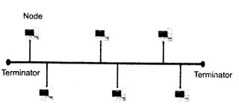
- It is easy to set-up and extend bus network.
- Cable length required for this topology is the least compared to other networks.
- Bus topology costs very less.
- Linear Bus network is mostly used in small networks. Good for LAN.
(ii) Star Topology:
Advantages:
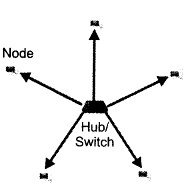
- As compared to Bus topology it gives far much better performance, signals don’t necessarily get transmitted to all the workstations. Performance of the network is dependent on the capacity of central hub.
- Easy to connect new nodes or devices. In star topology, new nodes can be added easily without affecting rest of the network. Similarly, components can also be removed easily.
- Centralized management. It helps in monitoring the network.
- Failure of one node or link doesn’t affect the rest of network. At the same time its easy to detect the failure and troubleshoot it.
(iii) Ring Topology:
Advantages:
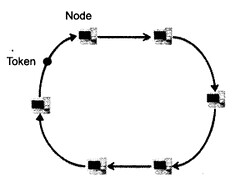
- This type of network topology is very organized. Each node gets to send the data when it receives an empty token. This helps to reduces chances of collision. Also in ring topology, all the traffic flows in only one direction at very high speed.
- Even when the load on the network increases, its performance is better than that of Bus topology.
- There is no need for network server to control the connectivity between workstations.
- Additional components do not affect the performance of network.
- each computer has equal access to resources.
(iv) Mesh Topology:
Advantages:
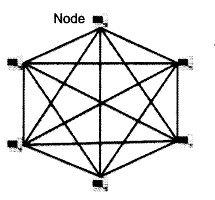
- Data can be transmitted from different devices simultaneously. This topology can withstand high traffic.
- Even if one of the components fails there is always an alternative present. So data transfer doesn’t get affected.
- Expansion and modification in topology can be done without disrupting other nodes.
(v) Tree Topology:
Advantages:
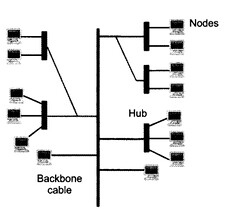
- It is an extension of Star and bus Topologies, so in networks where these topologies can’t be implemented individually for reasons related to scalability, tree topology is the best alternative.
- Expansion of Network is possible and easy.
- Here, we divide the whole network into segments (star networks), which can be easily managed and maintained.
- Error detection and correction is easy.
- Each segment is provided with dedicated point-to-point wiring to the central hub.
- If one segment is damaged, other segments are not affected.
ADDITIONAL QUESTIONS SOLVED
I. Multiple Choice Questions
Question 1.
What is the extended form of WiFi? types of network cards.
(a) Wireless Function
(b) Wireless Fidelity
(c) Wireless Fiction
(d) Wireless Fields
Answer:
(b)
Question 2.
Which one is not an example of physical network topologies?
(a) Train Topology
(b) Bus Topology
(c) Tree Topology
(d) Star Topology
Answer:
(a)
Question 3.
Which computing is also known as client-sever computing?
(a) Distributed
(b) Collaborative
(c) Centralized
(d) Hybrid
Answer:
(c)
Question 4.
In which topology, least cable length is required?
(a) Bus
(b) Ring
(c) Tree
(d) Star
Answer:
(a)
Question 5.
There are ————— types of network cards.
(a) Three
(b) Five
(c) Six
(d) Two
Answer:
(d)
II. Very Short Answer Type Questions
Question 1.
Name one of the hardware required to setup a computer network.
Answer:
Network cables.
Question 2.
Give the types of internal network cards.
Answer:
Peripheral Component Interconnect (PCI) and Industry Standard Architecture (ISA).
Question 3.
Give the variants of External Network Cards.
Answer:
Wireless and USB based.
Question 4.
USB cards are connected through which points?
Answer:
USB port.
Question 5.
In which parts, basic structure of an optical fibre is divided?
Answer:
Three.
III. Short Answer Type Questions
Question 1.
What is a computer network? Also, give two characteristics.
Answer:
A computer network is a sytem in which multiple computers are connected to each other. Two characteristics of computer network are as follows:
- Shares resources from one computer to another.
- Create files in one computer, access those files from other computers.
Question 2.
List some of the hardwares required to setup a computer network.
Answer:
Some of the hardwares required to setup a computer network are given below:
- Routers
- Network cables
- Internal network cards
- External network cards
Question 3.
What is a Router?
Answer:
A router is a device which acts as the central point among computers and other devices that are part of a network. A router is equipped with holes called ports and the devices are connected to a router using network cables.
Question 4.
Define centralized computing system.
Answer:
Centralized computing is also known as client-server computing. In this system, multiple computers are jointed to one mainframe computer. These connected computers are called ‘clients’ or ‘nodes’. These needs are only connected to server.
Question 5.
Explain any one physical network topology?
Answer:
One of the physical network topologies is ‘Bus’ topology. It is easy to set-up and extend bus network. Least cable length is required for this topology as compare to other topologies. Bus topology costs very less. Linear bus network is mostly used in small networks.
IV. Long Answer Type Question
Question 1.
What is a network card? Also, explain its types.
Answer:
Network card is a necessary component of a computer without which a computer cannot be connected over a network. It is also known as network adaptor or Network Interface Card (NIC). Most computers have pre-installed network card. There are two types of network cards—Internal and External Network Cards.
- Internal Network Cards: Motherboard has a slot for internal network card wThere it is to be inserted. Internal network cards are of two types, in which first type uses Peripheral Component Interconnect while the second types uses Industry Standard Architecture. Network cables are required to provide network access.
- External Network Cards: External network cards come in two type—Wireless and USB based. Wireless Network Card need to be inserted into the motherboard but no network cable is required to connect to network.
We hope the given RBSE Solutions for Class 9 Information Technology Chapter 3 Computer Communication and Network will help you. If you have any query regarding Rajasthan Board RBSE Class 9 Information Technology Chapter 3 Computer Communication and Network, drop a comment below and we will get back to you at the earliest.